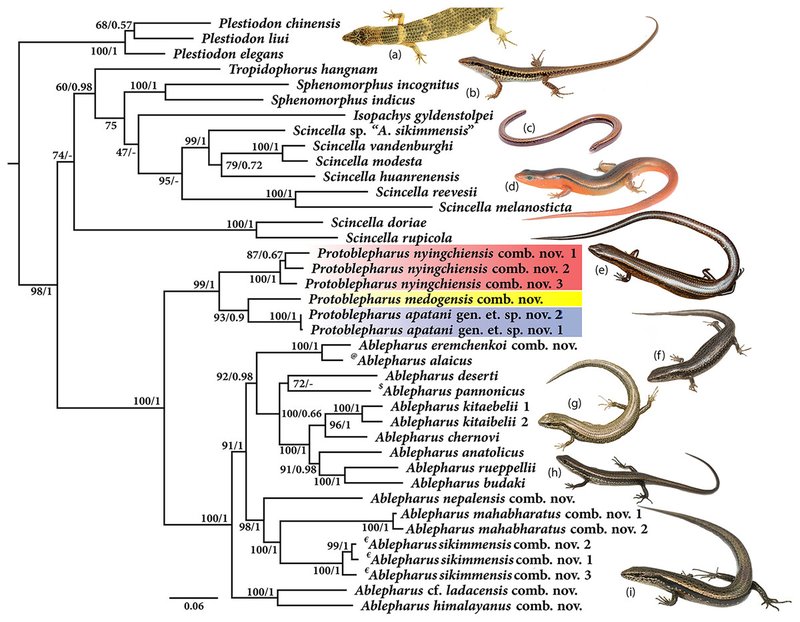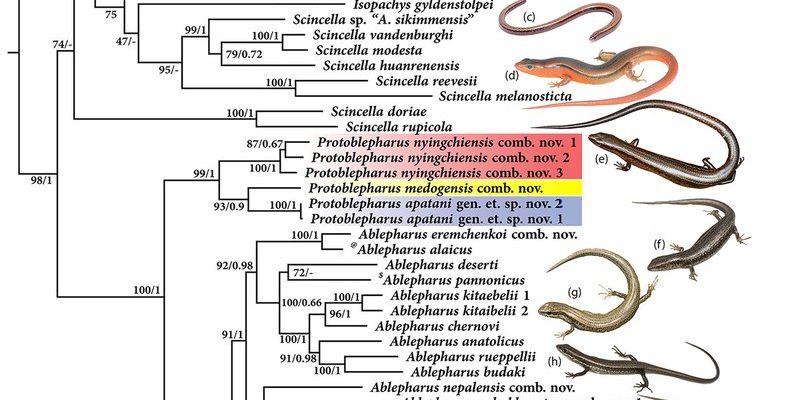
Imagine skinks as the unsung heroes of the lizard world. Found on nearly every continent except Antarctica, they come in various shapes, sizes, and colors, each equipped with unique adaptations to thrive in their environments. Learning about their evolutionary journey is like flipping through an ancient book of life, uncovering how these creatures have navigated the challenges of their habitats. So, grab a cup of coffee, and let’s dive into the remarkable evolutionary history of the skink!
Origins of Skinks
Skinks belong to the family Scincidae, with over 1,500 different species. The family roots itself deep in the tree of life, dating back to the late Cretaceous period, around 100 million years ago. It’s hard to imagine that these small lizards share a lineage with dinosaurs! While skinks are now a diverse group, their ancestors likely resembled modern-day lizards closely, featuring long bodies and relatively short limbs.
One of the key traits that set skinks apart from other lizards is their smooth, shiny scales. This unique characteristic likely evolved as a response to their environment. The sleekness helps them move quickly through foliage and escape predators, much like how a well-oiled machine runs smoothly. By adapting to their surroundings, skinks have thrived in shifting climates and landscapes.
Over time, skinks have branched out into various ecological niches. This diversification has led to different forms and behaviors, allowing them to inhabit various habitats—from lush rainforests to arid deserts. Some have evolved to be burrowing specialists, while others are excellent climbers. Each adaptation showcases how evolution shapes life on Earth.
Physical Transformations and Adaptations
One of the most striking features of skinks is their body shape. Many skinks have elongated bodies and short limbs, which can make them appear almost snake-like. This design isn’t just for looks; it’s a clever adaptation for moving quickly through tight spaces and underbrush. The evolution of this body shape stems from their historical need to evade predation and hunt for food efficiently.
In contrast, some skinks, like the often colorful and intriguing *Tiliqua*, also known as the blue-tongued skink, have evolved thicker bodies and more robust limbs. These adaptations can help them defend themselves against predators. Blue-tongued skinks display bright blue tongues as a warning mechanism, letting potential threats know they are not easy prey. Talk about nature’s creative defense strategies!
Another fascinating adaptation is how some skinks have lost their limbs entirely. Yep, you read that right! Some species have transitioned into a limbless form, resembling snakes. This change likely provided an advantage in specific environments where slithering through soil or leaf litter made hunting and hiding more effective. The evolution of these unique body plans highlights the remarkable versatility of skinks as they adapt to differing survival challenges.
Behavioral Adaptations
Skinks also exhibit a range of interesting behaviors adapted for survival. Many species are diurnal, meaning they’re active during the day. This activity pattern allows them to maximize their hunt for food, bask in the sun, and avoid nighttime predators. Their social behavior can be quite fascinating, too! Some skinks live alone or in small groups and exhibit territoriality.
A great example is the *Egernia* genus, commonly known as the social skinks. These skinks are known for their family-oriented behavior, often living in groups and displaying strong social bonds. This adaptability can enhance their survival chances by providing safety in numbers, much like a tight-knit community working together to thrive.
Skinks are also known for their impressive camouflage. Many species sport natural color patterns, allowing them to blend seamlessly into their surroundings, whether in forests, grasslands, or rocky outcrops. This skill helps them avoid predators and sneak up on prey. Honestly, who doesn’t love a good game of hide-and-seek in the wild?
Skinks and Their Ecosystems
Skinks play an essential role in their ecosystems. They are omnivores, feeding on plants, insects, and other small creatures, which puts them in the middle of the food chain. By consuming various food sources, skinks help maintain a balance in their ecosystems, acting as both predator and prey.
Their foraging habits contribute to soil health as well. As skinks dig and burrow, they aerate the soil, which can benefit plant growth. This unseen labor promotes a thriving ecosystem where various life forms can flourish. Think of skinks as the unsung gardeners of the animal world!
However, skinks face significant challenges in today’s world. Habitat loss, climate change, and invasive species threaten their survival. Protecting these lizards is crucial not only for their species but also for the health of their ecosystems. By understanding their evolutionary history and integral role, we can appreciate and advocate for their survival.
Conservation and Future Prospects
With many skink species experiencing population declines, conservation efforts are more important than ever. Organizations and researchers are working to raise awareness about the unique challenges skinks face. By protecting their habitats and ensuring ecosystems remain intact, we can help secure a future for these remarkable reptiles.
You might wonder how you can contribute to skink conservation efforts. Every little action counts! Supporting wildlife preservation organizations, advocating for environmental protections, and educating others about the importance of biodiversity can all make a difference. After all, saving one species can have a positive ripple effect on countless others.
Furthermore, scientific research plays a vital role in understanding the evolutionary history and adaptations of skinks. This knowledge can help guide conservation strategies, ensuring that these incredible creatures continue to thrive for generations to come.
The evolutionary history of the skink is a testament to the wonders of nature and adaptation. From their ancient roots to their diverse forms and behaviors, skinks tell a rich story of survival and resilience. As they navigate the challenges of their environments, they remind us of the intricate web of life we share this planet with.
By learning about these little lizards, we gain insight into the broader story of evolution and the interconnectedness of all living things. So, the next time you spot a skink sunbathing on a rock or darting through the grass, take a moment to appreciate this remarkable creature and the journey that brought it here. After all, the story of the skink is truly a journey worth understanding!

